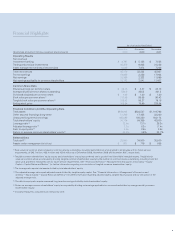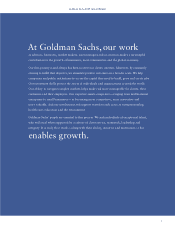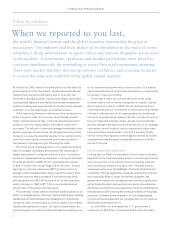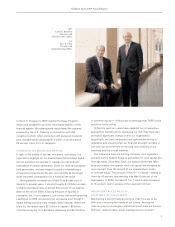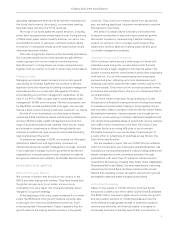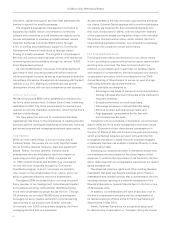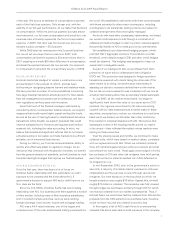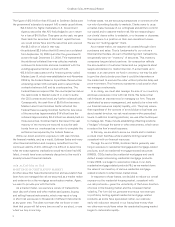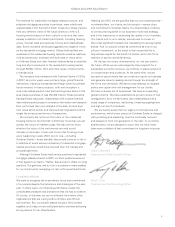Goldman Sachs 2009 Annual Report Download - page 10
Download and view the complete annual report
Please find page 10 of the 2009 Goldman Sachs annual report below. You can navigate through the pages in the report by either clicking on the pages listed below, or by using the keyword search tool below to find specific information within the annual report.
8
The gure of $12.9billion that AIG paid to GoldmanSachs post
the government’s decision to support AIG is made up as follows:
• $4.8billion for highly marketable U.S. Government
Agency securities that AIG had pledged to us in return
for a loan of $4.8billion. They gave us the cash, we gave
them back the securities. If AIG hadn’t repaid the loan,
we would simply have sold the securities and received
the $4.8billion of value in that way.
• An additional $2.5billion that AIG owed us in collateral
from September 16, 2008 (just after the government’s
action) through December 31, 2008. This represented
the additional collateral that was called as markets
continued to deteriorate and was consistent with the
existing agreements that we had with AIG.
• $5.6billion associated with a nancing entity called
Maiden Lane III, which was established in mid-November
2008 by the Federal Reserve to purchase the securities
underlying certain CDS contracts and to cancel those
contracts between AIG and its counterparties. The
Federal Reserve required that the counterparties deliver
the cash bonds to Maiden Lane III in order to settle
the CDS contracts and avoid any further collateral calls.
Consequently, the cash ow of $5.6billion between
Maiden Lane III and GoldmanSachs re ected the
Federal Reserve paying GoldmanSachs the face value
of the securities (approximately $14billion) less the
collateral (approximately $8.4billion) we already held on
those securities. GoldmanSachs then spent the vast
majority of the money we received to buy the cash
bonds from our counterparties in order to complete the
settlement as required by the Federal Reserve.
While our direct economic exposure to AIG was minimal,
the nancial markets, and, as a result, GoldmanSachs and every
other nancial institution and company, bene ted from the
continued viability of AIG. Although it is dif cult to determine
what the exact systemic implications would have been had AIG
failed, it would have been extremely disruptive to the world’s
already turbulent nancial markets.
OUR ACTIVITIES IN THE
MORTGAGE SECURITIZATION MARKET
Another issue that has attracted attention and speculation has
been how we managed the risk we assumed as a market maker
and underwriter in the mortgage securitization market. Again,
we want to provide you with the facts.
As a market maker, we execute a variety of transactions
each day with clients and other market participants, buying
and selling nancial instruments, which may result in long
or short risk exposures to thousands of different instruments
at any given time. This does not mean that we know or even
think that prices will fall every time we sell or are short, or rise
when we buy or are long.
In these cases, we are executing transactions in connection with
our role of providing liquidity to markets. Clients come to us as
a market maker because of our willingness and ability to commit
our capital and to assume market risk. We are responding to
our clients’ desire either to establish, or to increase or decrease,
their exposure to a position on their own investment views.
We are not “betting against” them.
As a market maker, we assume risk created through client
purchases and sales. This is fundamental to our role as a
nancial intermediary. As part of facilitating client transactions,
we generally carry an “inventory” of securities. This inventory
comprises long and short positions. Its composition re ects
the accumulation of customer trades and our judgments about
supply and demand or market direction. If a client asks us to
transact in an instrument we hold in inventory, we may be able
to give the client a better price than it could nd elsewhere in
the market and to execute the order without potential delay and
price movement. This inventory represents a risk position that
we manage continuously.
In so doing, we must also manage the size of our inventory
and keep exposures in line with risk limits. We believe that
risk limits are an important tool in managing our rm. They are
established by senior management, and scaled to be in line with
our nancial resources (capital, liquidity, etc.). They help ensure
that regardless of the opinions of an individual or business unit
about market direction, our risk must remain within prescribed
levels. In addition to selling positions, we use other techniques
to manage risk. These include establishing offsetting positions
(“hedges”) through the same or other instruments, which serve
to reduce the rm’s overall exposure.
In this way, we are able to serve our clients and to maintain
a robust client franchise while prudently limiting overall risk
consistent with our nancial resources.
Through the end of 2006, GoldmanSachs generally was
long in exposure to residential mortgages and mortgage-related
products, such as residential mortgage-backed securities
(RMBS), CDOs backed by residential mortgages and credit
default swaps referencing residential mortgage products.
In late 2006, we began to experience losses in our daily
residential mortgage-related products P&L as we marked down
the value of our inventory of various residential mortgage-
related products to re ect lower market prices.
In response to those losses, we decided to reduce our overall
exposure to the residential housing market, consistent with
our risk protocols — given the uncertainty of the future direction
of prices in the housing market and the increased market
volatility. The rm did not generate enormous net revenues
or pro ts by betting against residential mortgage-related
products, as some have speculated; rather, our relatively
early risk reduction resulted in our losing less money than
we otherwise would have when the residential housing market
began to deteriorate rapidly.
Goldman Sachs 2009 Annual Report


